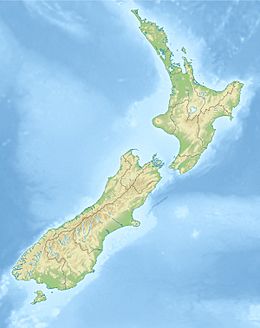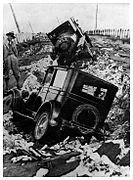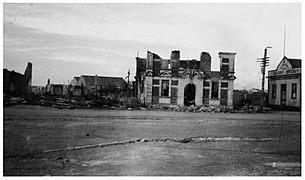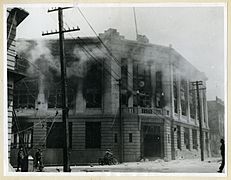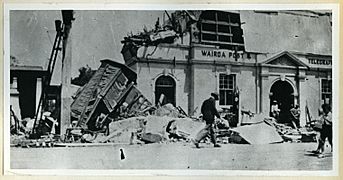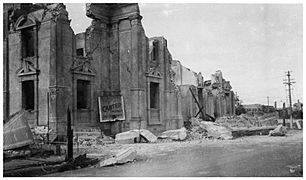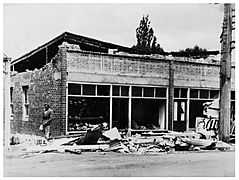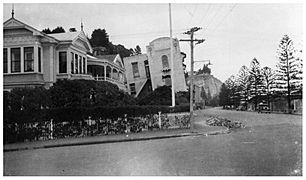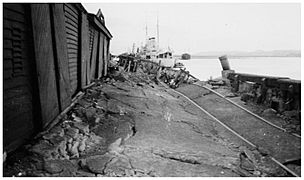1931 Hawke's Bay earthquake facts for kids
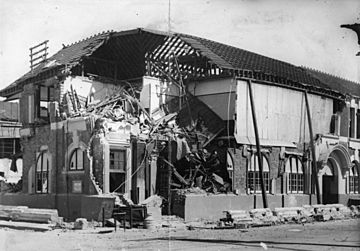 |
|
| UTC time | 1931-02-02 22:46:52 |
|---|---|
| ISC event | 906607 |
| USGS-ANSS | ComCat |
| Local date | 3 February 1931 |
| Local time | 10:47 NZDT |
| Magnitude | 7.8 Ms, 7.7 Mw |
| Depth | 20 km (12 mi) |
| Epicenter | 39°18′S 177°00′E / 39.3°S 177.0°E |
| Areas affected | New Zealand |
| Tsunami | moderate |
| Casualties | 256 dead, thousands injured |
The 1931 Hawke's Bay earthquake, also known as the Napier earthquake, was a very strong earthquake that hit New Zealand. It happened at 10:47 am on February 3, 1931. This earthquake killed 256 people and injured thousands more. It caused huge damage to the Hawke's Bay area. It is still New Zealand's deadliest natural disaster.
The earthquake's center was about 15 kilometers north of Napier. It shook the ground for two and a half minutes. The earthquake had a magnitude of 7.8. After the main quake, there were 525 smaller quakes, called aftershocks, in the next two weeks. By the end of February, 597 aftershocks had been recorded. People felt the main earthquake across much of New Zealand. Reports came from as far south as Timaru on the east coast of the South Island.
Contents
Why Earthquakes Happen in New Zealand
New Zealand sits on the edge where two large pieces of the Earth's crust, called plates, meet. These are the Indo-Australian Plate and the Pacific Plate. These plates are always moving, but very slowly.
In the South Island, these plates mostly slide past each other. In the North Island, one plate slides under the other. This movement causes a lot of stress in the Earth's crust. When this stress builds up too much, it suddenly releases. This release causes an earthquake. The 1931 Hawke's Bay earthquake happened when a large underground crack, or fault, suddenly moved.
How the Earthquake Affected People and Places
Nearly all buildings in the main parts of Napier and Hastings fell down. One newspaper said that "Napier as a town has been wiped off the map." The earthquake killed 161 people in Napier, 93 in Hastings, and two in Wairoa. Thousands more were hurt, and over 400 people had to go to the hospital.
Changes to the Land
The earthquake changed the land a lot. The coastal areas around Napier lifted up by about two meters. The biggest change was that about 40 square kilometers of the sea-bed became dry land. This included Ahuriri Lagoon. It lifted more than 2.7 meters, draining 2230 hectares of water. Today, this new land is home to Hawkes Bay Airport, houses, factories, and farms.
Fires After the Quake
Minutes after the earthquake, fires started in shops in Hastings Street, Napier. The fire department tried to put out the first fire. But then a second fire started in a shop behind the Masonic Hotel. The hotel quickly caught fire. The wind also grew stronger, blowing the fires across the city. Water pipes were broken, so firefighters could not get water. They pumped water from Clive Square to stop the fires from spreading south. Only a few buildings in central Napier survived. Some buildings did not fall in the quake but were burned down by the fires. People trapped in the rubble could not be saved in time and sadly burned. By Wednesday morning, most fires were out, but the ruins kept smoking for days. In Hastings, the fires were put out quickly.
Help Arrives
The death toll could have been much higher if the Royal Navy ship HMS Veronica had not been in port. Minutes after the quake, the Veronica sent radio messages asking for help. The sailors worked with survivors to fight fires, rescue trapped people, and give medical aid. The Veronica's radio was used to tell the world about the disaster and ask for help.
Sailors from two cargo ships, the Northumberland and Taranaki, also helped. Two other navy ships, HMS Diomede and HMS Dunedin, were sent from Auckland. They brought food, tents, medicine, blankets, and a team of doctors and nurses. These ships arrived on February 4 and helped a lot until February 11.
Stories of Survival and Loss
A group of prisoners working at Bluff Hill in Napier were caught in a landslide. Four of them were buried. The other prisoners dug them out, but two had died. The remaining prisoners did not try to escape. They went back to Napier Jail.
In Taradale, the Mission Estate had just opened a new building in February 1931. The next day, the earthquake hit, causing serious damage. Two priests and seven students died when the stone chapel was destroyed. In Havelock North, St Luke's church was damaged just before a wedding. The couple still got married later that day, but outside.
Power Outages and Transport
The entire Hawke's Bay and Gisborne regions lost electricity. Power was back on in Waipukurau within two hours and in Gisborne within ten hours. In Napier, power lines and equipment were badly damaged. Limited power was back in Napier and Hastings on February 4. Full power was restored to Napier on March 29.
The earthquake also destroyed Napier's tram system. The tracks were twisted, and the trams were never used again. New Zealand's first commercial air crash happened six days after the quake. A small plane carrying people and supplies crashed near Wairoa. All three people on board died.
Newspaper offices were also destroyed. The Napier Daily Telegraph and the Hawke's Bay Herald offices in Hastings both fell down.
Aftershocks Continue
On February 13, Hawke's Bay was hit by another strong earthquake. This was an aftershock with a magnitude of 7.3. It was New Zealand's fourth strongest earthquake ever recorded at that time. People ran for safety as damaged buildings cracked and fell again. Some areas felt this aftershock more strongly than the first quake.
Aftershocks kept shaking Hawke's Bay often until July 1931. After that, they happened less than once a day. Smaller aftershocks continued for several years. The last big one was in April 1934. In total, 597 earthquakes were recorded in Hastings during February 1931. More than 900 were recorded by the end of December 1931.
Rebuilding Hawke's Bay
The government quickly realized that the Napier council needed help to rebuild. They appointed two special leaders, John Barton and Lachlan Bain Campbell, to manage the rebuilding.
The earthquake led to a major review of New Zealand's building codes. The old rules were not strong enough. Many buildings built in the 1930s and 1940s were made much stronger. Because of these new rules, there are still only four buildings in Hawke's Bay taller than five stories. Most of the rebuilding happened in the 1930s when Art Deco style was popular. This means Hawke's Bay now has one of the best collections of Art Deco buildings in the world.
Ten years after the earthquake, a newspaper said that Napier had risen like a phoenix, a mythical bird that rises from ashes. The principal of Napier Girls' High School in 1931 said, "Napier today is a far lovelier city than it was before."
Images for kids


